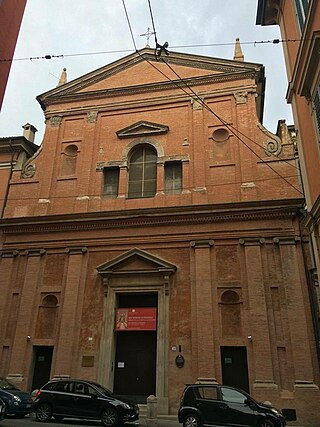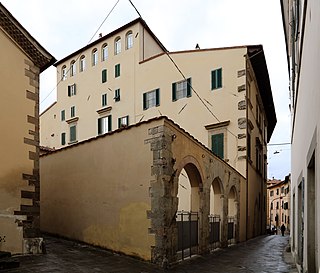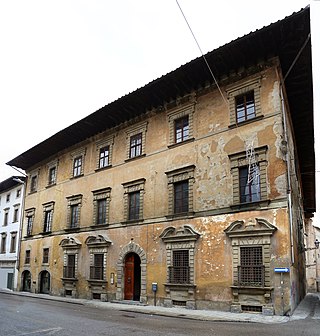Related Research Articles

Pescia is an Italian city in the province of Pistoia, Tuscany, central Italy.

Giacinto Gimignani was an Italian painter, active mainly in Rome, during the Baroque period. He was also an engraver in aquaforte.
The Art Collection of the Fondazione Cassa di Risparmio di Perugia is a private collection of artworks, mainly from the region of Perugia, acquired by former financial institution Cassa di Risparmio di Perugia. In 1992, after the passage of the Legge Amato, the collection was transferred from the bank to the Fondazione Cassa di Risparmio di Perugia, also known as the Fondazione Perugia. The collection is divided among two locations in the city of Perugia: the Palazzo Graziani and the Palazzo Baldeschi. The Palazzo Graziani (1554–1569) was designed by Jacopo Barozzi da Vignola. The building is also notable for its sumptuous main salon, the Sala della Presidenza, which was decorated at the end of the 19th century with large canvases and frescoes painted by Annibale Brugnoli, recalling both events of the Risorgimento and the history of Perugia. The Palazzo Baldeschi al Corso was obtained by the foundation on November 28, 2002.

Palazzo Castiglioni is an Art Nouveau palace of Milan, northern Italy. It was designed by Giuseppe Sommaruga in the Liberty style and built between 1901 and 1903. The rusticated blocks of the basement imitate a natural rocky shape, while the rest of the decorations are inspired by 18th century stuccos. The building is now used as the seat of the Unione Commercianti di Milano.

The Palazzo di Residenza della Cassa di Risparmio di Bologna is a 19th-century palace, erected as Neo-Renaissance architecture, located on Via Farini #22, Bologna, region of Emilia-Romagna, Italy. It was built and is still the headquarter of the Cassa di Risparmio in Bologna.

Palazzo Malvezzi Campeggi is a Renaissance palace located on Via Zamboni number 22, at the corner (southwest) with Via Marsala, in central Bologna, region of Emilia Romagna, Italy. It stands across from San Giacomo Maggiore, and just northeast of the Palazzo Magnani. It presently houses the Law Faculty of the University of Bologna.

San Giorgio in Poggiale is a Baroque-style, deconsecrated, former Roman Catholic church, now serving as the Art and History Library of Fondazione Carisbo, located on Via Nazario Sauro 20 in central Bologna, Italy.
Banca Cassa di Risparmio di Firenze S.p.A. known as Banca CR Firenze, was an Italian savings bank. Once a listed company, the group now part of Intesa Sanpaolo since 2007.
Cassa di Risparmio is the Italian word for savings bank, and may refer to:
Cassa di Risparmio di Pistoia e della Lucchesia is an Italian regional bank based in Pistoia, Tuscany. The bank was a subsidiary of Banca CR Firenze, with Intesa Sanpaolo as the ultimate holding company.

Cassa Depositi e Prestiti Reti S.p.A. is an Italian holding company. It is a joint venture of Cassa Depositi e Prestiti, State Grid Corporation and other investors.
Associazione di Fondazioni e di Casse di Risparmio S.p.A. is an Italian banking association. The members were the savings banks of Italy, or the foundation that originate from the reform trigger by Legge Amato.
Santa Paolo Apostolo is a Roman Catholic church located on Via Bartocci in the town of Fiastra, province of Macerata, in the region of Marche, Italy.
The Monastery of San Giuseppe is a Roman Catholic cloistered female convent located in Via Regina Margherita #8 at the town limits of Mogliano, province of Macerata, in the region of Marche, Italy.

The Palazzo Sozzifanti also known as the Palazzo Buontalenti is a Renaissance-style palace located at the intersection of Via del Carmine, Via de' Rossi, Via Abbi Pazienza and Via Sant'Andrea in central Pistoia, Tuscany, Italy. The palace is used in 2019 as a temporary exhibition site by the Cassa di Risparmio di Pistoia and Pescia Foundation.

The Palazzo Marchetti is a Baroque-style palace located at Via Curtatone e Montanara in central Pistoia, Tuscany, Italy. The palace, which once served as a civic art gallery, is used in 2019 as a civic archive for various family collections of documents.
The Palazzo Puccini is a former aristocratic palace located at Via Can Bianco in central Pistoia, Tuscany, Italy. The palace is now used as a boutique guest house/residence.

The Palazzo Rospigliosi a Via del Duca is a former aristocratic palace located at Via Ripa del Sale number 3 in central Pistoia, Tuscany, Italy. The palace was the birthplace in 1600 of Giulio Rospiglio, later Pope Clement IX.

San Leone, once called the oratory or church of Santo Spirito, is a small Baroque-style Roman Catholic church located adjacent to the Vivarelli Colonna in Pistoia, region of Tuscany, Italy. In 2017, restoration of the Baroque era frescoes in the apse and ceilings were completed.
Mario Nannini was an Italian painter, active in a Futurist style.
References
- ↑ Fondazione di Cassa di Risparmio di Pistoia and Pescia.
- ↑ Pistoia e il suo territorio: Pescia e i suoi dintorni: guida del forestiero, by Giuseppe Tigri, Tipografia Cino, Pistoia (1853): page 174-175.